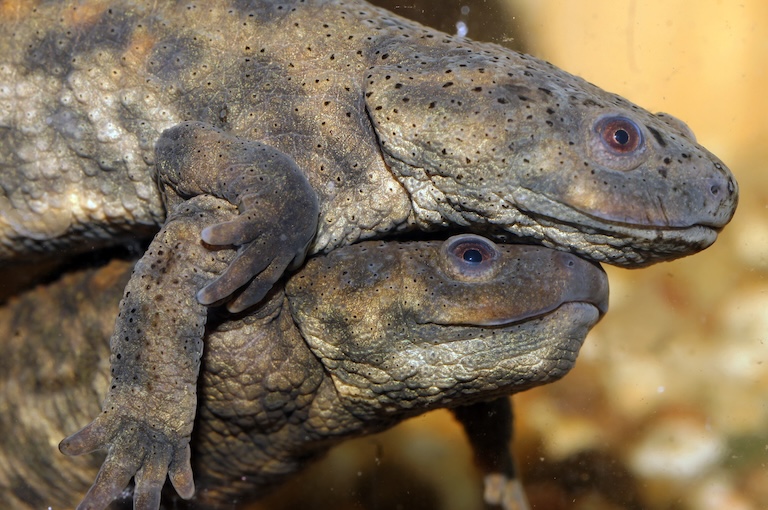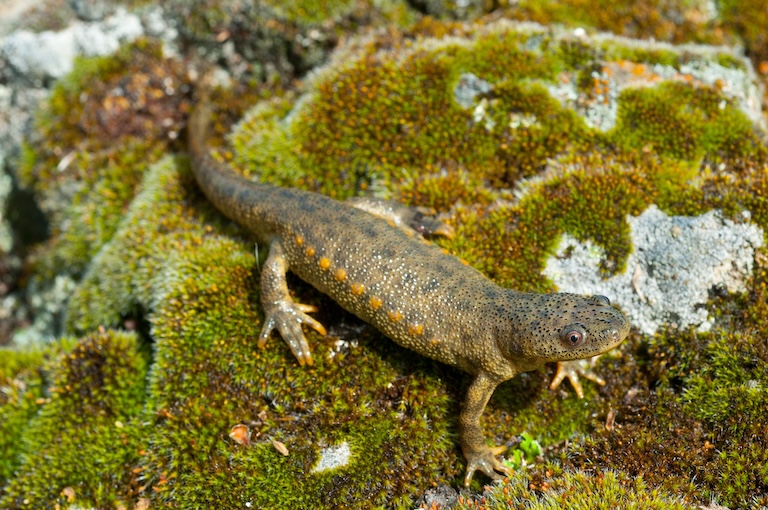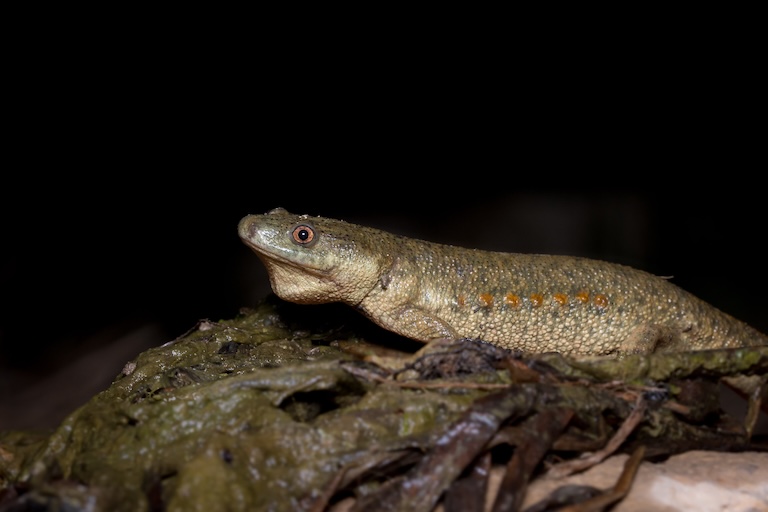Iberian Ribbed Newt Profile
The Iberian ribbed newt sounds like something you’d pick up at 2 am in a beach Pharmacy in Ibiza.
But this would be an ignorant assumption for a couple of reasons.
Firstly, the Balearics are geographically distinct from Iberia, but never mind all that because this so-called “sharp-ribbed salamander” knows nothing of her pleasure and only how to bring the pain.

Iberian Ribbed Newt Facts Overview
| Habitat: | Semi-aquatic, scrub, open woodland and cultivated land, small bodies of still and slow-moving water |
| Location: | Spain, Portugal, and North Africa. |
| Lifespan: | 10 years in the wild, longer in captivity |
| Size: | Up to around 30 cm (12 in) |
| Weight: | Not reported |
| Colour: | Green-grey or brown, sometimes with coloured spots on the sides |
| Diet: | Insects, worms, molluscs, tadpoles |
| Predators: | Few |
| Top Speed: | Slow |
| No. of Species: | 1 |
| Conservation Status: | Least Concern |
This spiky little water sausage is both a newt and, by extension, a salamander. It has excellent regenerative skin and an impressive immune system.
And it needs these to repair itself after exploding its ribs out of its body in self-defence.
But as if that didn’t clarify things enough, its secreted toxins will hopefully cement the idea that this is not something you want in you.
Interesting Iberian Ribbed Newt Facts
1. They’re salamanders
There’s sometimes confusion about the difference between these two groups, as they both look sort of like slippery, wet lizards.
But they’re not lizards, not even close. The two lines stopped sharing body fluids with one another over 330,000,000 years ago before dinosaurs evolved and amphibians probably regretted not staying in touch.
Newts and salamanders are both groupings of amphibians, the salamanders, being an order, are the larger group that contains the newts within it.
But even more, the true salamanders share a family with the newts, so the differences become a lot smaller. The newts are a subfamily of semiaquatic salamanders, which means they tend to spend more time out of the water than the other family members.
So, all newts are salamanders, but not all salamanders are newts. This one is, though. And unlike most newts, it spends almost all its time in the water.

2. They’re large
Newts are generally small by salamander standards, given that the largest salamander is a two-metre, 30 kg behemoth. But of the newts, the Iberian ribbed is a real Magnum.
This is the largest European salamander and one of the largest in the world, growing to around 30 cm long and packing some decent meat. For a newt.
And this meat can really grow. 1
3. They regenerate well
Human medicine is mostly focused on the facilitation of human healing, which in most cases is the use of sub-optimal tissue to replace damaged stuff with what we call scars.
Scars are fine when it’s a superficial wound on the skin of the arm, for example, but not so great when it’s the pulmonary tissue around the heart.
So, cracking the code for the regeneration of tissues, something many geneticists think is still encoded in our genes, is the holy grail of healing.
While this is mostly out of reach as of yet, it isn’t science fiction, as we know that the fingertips, liver, and topmost layers of skin are capable of just growing back perfectly.
If scientists could figure this out, we could work towards regrowing limbs or teeth or hearts, rather than just dying (or at least struggling to beer bottles) when they give out.
Animals like the salamanders hold a lot of clues to this puzzle. This group, in particular, have outstanding abilities to regenerate and can grow back more or less anything a friendly lab technician crushes or cuts.
Even their spinal cord repairs itself with no scarring, and this gives the animal an almost supernatural ability to endure harm. So, naturally, it explodes its ribs out sometimes. 2
4. Wolverine ribs
Technically, all newts are ribbed, in that they have ribs, but this one isn’t afraid to show them off. Like the [wolverine frog] that we covered recently, this newt uses a brutal method of self-defence by pushing its bones through its own skin.
Their first line of defence is to wriggle, and these chunky guys swim around with their arms held almost behind their backs, almost inviting you to grab them.
But don’t. Because their ribs can pierce skin bodies and stab you, and they pack venom, too. 3

5. They’re Venomous
Plenty of amphibians secrete toxins, but few are truly able to inject them like the ribbed newt. Grabbing this chunky sausage can result in a sting from the penetrating ribs mixed with the toxic compounds in its skin.
This has happened, and envenomation reports seem to suggest that on the scale of house fly to Brazilian wandering spider, symptoms are just a bit unpleasant.
This means they’re not likely to kill anyone, but considering the sacrifice they make by bursting at the seams, it seems like a bad idea to pick one up. Still, apparently, nobody told this to NASA. 4
6. They’re astronauts
In research presumably funded by the Overly Attached Girlfriend character, these newts were sent into space to figure out how well the females can hold live sperm safely in their cloacas, for months, until they find the right time to conceive.
Apparently, this will be useful for humans when we’re all living on spaceships in the year 2025. This species was literally sent into space to help humans understand microgravity, among other things, and the strangest part is yet to come.
The newts did everything they normally do on Earth, but better!
Regeneration was faster, sometimes twice as quick, and their fertility didn’t suffer at all, even after they made the 3g trip back to Earth.
7. They’re in decline
You might think that this makes them tough as nails and doing great, but the reality is that a continued existence on Earth is apparently harder than regrowing a spine in outer space.
Most populations are threatened locally, and over all the species is in decline. Still, it’s early days for this, and the IUCN has them listed as of Least Concern.
Their major threats at the moment by loss of habitat and all the other things that affect amphibians disproportionately like water quality and chemical runoff from farms. Introduced species like crayfish aren’t as bothered by the toxic spines and also contribute to the decline of the salamander.
Iberian Ribbed Newt Fact-File Summary
Scientific Classification
| Kingdom: | Animalia |
| Phylum: | Chordata |
| Class: | Amphibia |
| Order: | Urodela |
| Family: | Salamandridae |
| Genus: | Pleurodeles |
| Species: | waltl |
Fact Sources & References
- Tye-Dyed Iguana (2024), “Meet the Spanish Ribbed Newt! — Fun Facts and How to Take Care of Them!”, YouTube.
- Ahmed Elewa (2017), “Reading and editing the Pleurodeles waltl genome reveals novel features of tetrapod regeneration”, nature communication.
- Robert T. Nowak (1978), “Rib Penetration and Associated Antipredator Adaptations in the Salamander Pleurodeles waltl (Salamandridae)”, JSTOR.
- Joan Fuchs (2021), “Possible envenomation by a sting by Pleurodeles waltl (Iberian Ribbed Newt) resulting in mild symptoms”, Taylor & Francis Online.
